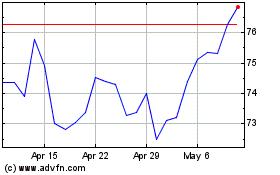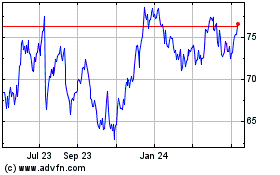UPDATE: Bank Shares Mostly Higher After 4Q Earnings Reports
January 20 2010 - 10:52AM
Dow Jones News
Bank shares opened mostly higher after quarterly reports from
Bank of America Corp. (BAC), Morgan Stanley (MS) and Wells Fargo
& Co. (WFC) showed improved bottom-line results but lingering
signs of credit troubles.
The three banks posted improvements over last year, when the
financial crisis and escalating credit problems led to huge
losses.
Bank of America came closer to the black, though shares were
little changed as the company posted a loss of $194 million in the
fourth quarter after its mammoth consumer loan books showed signs
of stabilizing, but its once-frothy revenue from trading fell
sharply. The results were still an improvement over a year ago. Its
shares rose 0.3% to $16.38 in recent trading.
Nonperforming assets at the bank also rose across the board as
levels of past-due mortgages, home-equity loans, business loans and
commercial real estate mortgages all rose. Foreign loans to
businesses provided a bright spot for the company.
Standard & Poor's analyst Matthew Albrecht wrote in a note
to clients that loan charge-offs and provisions declined
sequentially, suggesting an improved outlook, but the total loss
reserve keeps building. He said he expects a slight reserve build
this year and anticipates charge-offs rising again in the first
half.
Wells Fargo's results topped analysts' expectations. The company
swung to a profit of $2.82 billion, or 8 cents a share, compared
with a year-earlier loss of $2.73 billion, or 84 cents a share. It
said its earnings were reduced by 47 cents for TARP-related
preferred-stock dividends. Shares fell 0.7% to $28.07.
Net charge-offs at Wells Fargo rose to 2.71% of average loans
from 2.5% a quarter earlier and 2.11% a year earlier. The bank also
slimmed down on reserves, even though past-due loans are still
rising quickly. Wells put another $500 million into its coffers for
future losses, but those reserves are only equal to 103% of
troubled loans. In the prior quarter, its reserves were equal to
118% of highly delinquent loans.
"There's no doubt in my mind that the credit picture is
significantly worse than we've been led to believe this past year"
for the banking industry as a whole, Motley Fool senior analyst
James Early said.
Overall, the banks have been doing a little too well for too
long because of the support they have been getting, such as the
Troubled Asset Relief Program and low interest rates, he said. Most
TARP money is paid back, but the banks can still borrow money at a
low rate and lend money out at higher rates because of the steep
yield curve, he said, allowing them to make more money. If the
banks are still struggling even with that, it's a worry for
investors, Early added.
Morgan Stanley posted a fourth-quarter profit after big
prior-year losses as it sets the stage for further improvement this
year. One reason for the rebound is that former Chief Executive
John Mack pulled back in risk in the immediate aftermath of the
financial crisis, and then gave traders more freedom toward the end
of the year. Morgan Stanley's shares broke the mold, slipping 1.2%
to $30.80 in recent trading.
The securities firm reported that its Value At Risk, known on
Wall Street as VaR, rose to $132 million in the fourth quarter
compared with $105 million in the prior year and $118 million in
the third quarter. It stands for the maximum that could potentially
be lost trading on a single day.
On a heavy day for bank earnings, smaller financial firms also
saw their shares rise as bottom lines improved.
Jefferies Group Inc. (JEF) reversed a prior-year loss in the
fourth quarter while investment-banking revenue soared at the end
of 2009 amid a resurgence in deal making. Jefferies' shares jumped
2.6% to $26.50.
U.S. Bancorp's (USB) fourth-quarter profit jumped 82%, driven by
growth in net interest income and fee revenue. Chairman and CEO
Richard Davis also credited the company's expanding balance sheet
and recent investments in its branch network for the profit gains.
Shares rose 2.5% to $25.10.
Among asset managers, Bank of New York Mellon Corp.'s (BK)
fourth-quarter earnings soared as the firm freed itself of the
securities losses that hobbled it in past quarters. Shares
increased 3% to $30.41.
State Street Corp. (STT) shares climbed 5.9% to $45.73 as its
fourth-quarter profit more than doubled as the institutional
money-management firm's revenue from servicing and management fees
strengthened.
Analysts at Janney Montgomery Scott said a legal settlement,
lowered guidance and poor trends in ancillary revenues would likely
keep investors sidelined despite "decent trends in core servicing
fees."
Among regional banks, Marshall & Ilsley Corp.'s (MI)
fourth-quarter loss narrowed significantly amid a big year-earlier
charge, but the bank's results still missed analysts' forecasts.
"Despite the loss, there are some encouraging signs that credit
quality has stabilized and core earnings trends have improved,"
said President and Chief Executive Mark Furlong.
M&I's shares rose 3.6% to $7.23. SunTrust Banks Inc. (STI),
another regional, saw shares rise 1.3% to $23.66. Zions Bancorp
(ZION), considered more volatile than peers, climbed 3.8% to
$17.76.
-By Kerry Grace Benn, Dow Jones Newswires; 212-416-2353;
kerry.benn@dowjones.com
State Street (NYSE:STT)
Historical Stock Chart
From May 2024 to Jun 2024

State Street (NYSE:STT)
Historical Stock Chart
From Jun 2023 to Jun 2024
